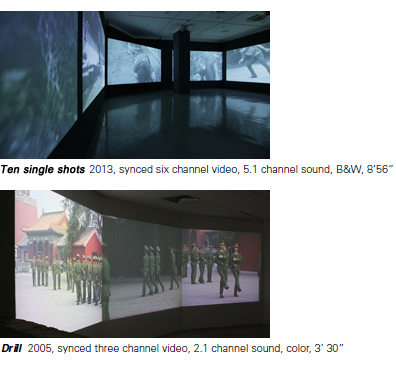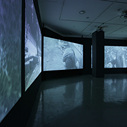2011 M.F.A. in Media Art, YONSEI University Graduate school of Communication & Arts, Seoul, Korea
2003 B.F.A. in Oriental painting, Seoul National University, Seoul, Korea
2014 Distant World, MAKESHOP Art Space,Paju, Korea
2013 Ten single shots, Gallery Zandari, Seoul, Korea
2012 Honest Person, Project Space SARUBIA, Seoul, Korea
2009 Harmony-Lip Sync Project2, kunsthausbethanien, Berlin, Germany
Jungju An uses diverse media such as video, photography, and sound to focus on society, institutions, and a reality that we might easy overlook as we gradually become desensitized to it. His works destroy once-familiar outlooks through different senses, reconstruct them, and give way to a new order so as to effectively rediscover reality in the process of making familiar things unfamiliar.



 Jungju An
Jungju An
Jury’s Statement
The three artist finalists selected for the 5th DOOSAN Artist Award are Jungju An (b. 1979), Yunsung Lee(b. 1985), and Dongju Kang (b. 1988). Each of these artists has a different trajectory, and their artworks reflect distinctly different characteristics. An creates socio-critical new media works that utilize video, photography, and sound, and reviews have noted that “he skillfully embodies the core essence of the senses with video works that remove the rhythms of senses functioning beyond the realm of phenomena and then exquisitely reconstruct them.” However, some have opined that the progression of his development and intensity with regard to his creative method has been relatively slow when compared to the impressive works that he presented at the beginning of his debut. At the same time, this negative aspect has led some viewers to expect that his experience in the DOOSAN Residency New York will be a positive stimulus for his creative process.
If Jungju An could be characterized as a mid-career artist who has held six solo exhibitions but whose career has been somewhat undervalued in the meantime,then Yunsung Lee and Dongju Kang are two promising artists who have held (respectively) one and two solo exhibitions and who have begun to the draw the attention of the art field.
Yunsung Lee borrows the method of “moe-personification” that originated in Japanese manga animation and uses a grammar of idealized youthful female characters to explore the subject of western classical painting. Reviewers have written that “the artist effectively grasps a theme that is difficult to develop in the context of canvas painting by developing a fitting painting style.” Although it may be tempting to misinterpret his painting as on the level of neo-pop with regard to elements that evoke the fetishization of amputees, positive reviews state that he has deepened the ancient cultural form of the nude torso’s figure by emphasizing the template of idealized youthful female characters.
Facing the common questions in our contemporary era of “what, when, how, where, and with whose hands should one draw?”,Dongju Kang attempts to redefine and reinvent the act of “painting” with a problematic form that corresponds to a post-medium situation. Distancing herself from the attitude of artists of her same generation who take on an affective stance by utilizing various mediums, her works have been well received, with critics writing that “she pursues invisibility and drawings of cloudage―with implications toward spatiality and temporality - with a faithful and patient attitude.”
As the DOOSAN Artist Award is an award system that is intended to support artists under the age of 40, of late the recipients in the fine art category have been mainly in their early- and mid-30s or over, and the average age of the finalists decreased last year. (At that time, Na Kim was 35 years old, Minae Kim was 33 years old, and Jaemin Cha was 28 years old.) Among this year’s finalists, Jungju An is 36 years old, Yunsung Lee is 30 years old, and Dongju Kang is 27 years old; thus, the trend of an accelerating downward generational shift continues.
In this year’s selection process, the ten shortlisted artists (eight artists and one duo team) were born between 1978 to 1988, encompassing artists who have been quietly engaged instable art making activities to emerging artists who have just begun to reveal their talent. As the field of nominees was not limited to fine art only, performers and designers were also nominated.
For purposes of comparison, let us trace back in memory to examine the cases of prior years. In the Award’s first selection in 2010, the nine shortlisted artists, who were born in the timespan from 1971 to 1974, were all artists who had succeeded in the construction of their art worlds. In contrast, in the Award’s second selection, the eleven shortlisted artists (eight artists and one team), who were all born in the timespan from 1971 to 1974, were a mixture of established artists and those of great potential. In other words, the year when we first sensed an indication of a generational shift was none other than 2011.
This gradual generational shift continued in the Award’s third selection in 2012, in which the eleven shortlisted artists (seven artist and two duo teams), who were born in the timespan from 1972 to 1981, encompassed artists who revealed their talent in their early ages to artists who were actively engaged in experimental works. In the Award’s fourth selection in 2013, eleven shortlisted artists (eight artists and one team), who were born in the timespan from 1974 to 1986, displayed great diversity intheir respective career positions, from the inside stars of the young generation who were cast in the spotlight early in their active careers to emerging stars who were independently pursuing the unique characteristics of their works.
(To sum up the above discussion, it demonstrates that the DOOSAN Artist Award has been a powerful force in support of a generational shift in the Korean contemporary art scene - a scene that had been making slow progress, but whose characteristic generational shift has, this year (like last year), slightly deepened. This begs the question: what kind of change will this shift in the Korean contemporary art scene provoke?)
To the artist finalists, the DOOSAN Artist Award promises some degree of monetary reward, the opportunity to experience the DOOSAN Residency New York (which comes with a budget for creative support), and a solo exhibition. Although it neither promises a brilliant spotlight nor offers an extensive support system, the Award has nevertheless played a fitting role in the Korean contemporary art scene. We hope that the Artist Award proceeds on as a cohesive positive cycle that will continue to seek out excellent young artists and engage them, and provide audiences with opportunities to encounter showcases of the artists’ new creative works.
We hope that this year’s three recipients will become driving forces to open up a new chapter of Korean contemporary art in our current decade. We look forward to your brilliant exploits and truly congratulate you on your award.
_ Sungwon Kim, Geun-jun Lim, Sun-ryung Cho